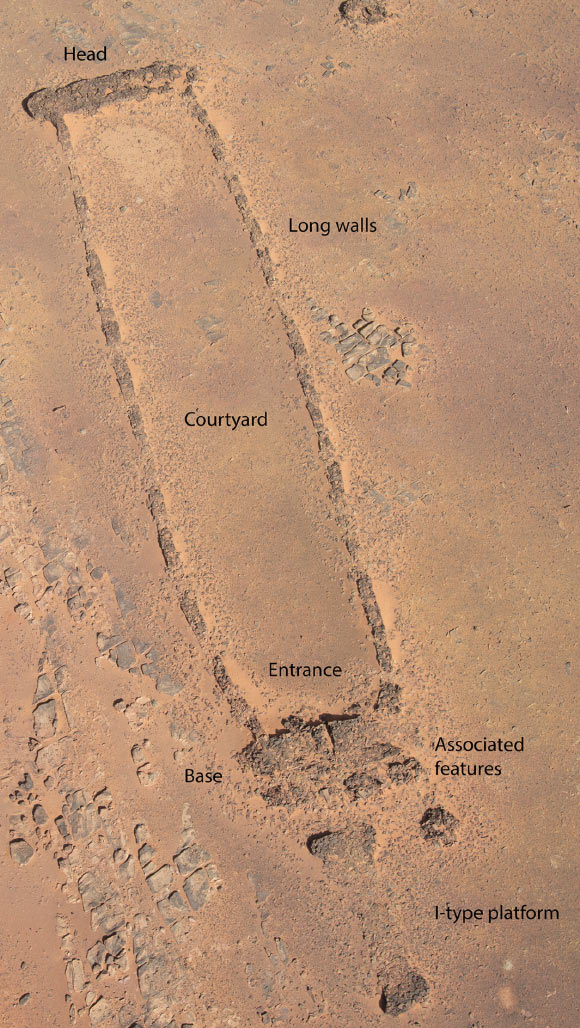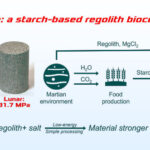Since the 1970s, monumental stone structures now known as mustatils (previously known as ‘gates’) have been documented across Saudi Arabia. However, it was not until 2017 that the first intensive and systematic study of these enigmatic monuments was undertaken, although that study could not determine their precise function. Recent excavations in the town of Al Ula have now determined that these structures fulfilled a ritual purpose, with specifically selected elements of both wild and domestic species deposited around a betyl (‘house of the god’).
Main architectural features of a mustatil located 55 km east of the modern city of Al Ula in Saudi Arabia. Image credit: Kennedy et al., 10.1371/journal.pone.0281904.
Built around 7,000 years ago, mustatils are rectangular, low-walled, stone structures that range from 20 to 600 m in length. Mustatil is the Arabic for rectangle, plural has been anglicized to mustatils.
Since the 1970s, more than 1,600 mustatils have been documented across Saudi Arabia.
However, it was not until 2017 that the first intensive and systematic study of this structure type was undertaken by University of Western Australia’s Professor David Kennedy.
That study was based on remote sensing data and was focused primarily upon the Harrat Khaybar and areas to the east.
Due to the nature of the data-set, Professor Kennedy was unable to hypothesize a precise function for these enigmatic structures. However, subsequent studies based on ground survey and preliminary excavation data revealed that the mustatil served a ritual purpose during the Arabian Late Neolithic.
In 2018, under the auspices of the Royal Commission for Al Ula, the first mustatil was excavated by Wael Abu-Azizeh with Oxford Archaeology, with these excavations revealing offering chambers with in situ ritual faunal deposits.
Over the course of the 2019 and 2020 excavation seasons, Professor Kennedy and colleagues excavated another mustatil — which is 140 m long and is constructed from local sandstone — 55 km east of the modern city of Al Ula.
The researchers’ analysis included identification of 260 fragments of animal skulls and horns, primarily from domestic cattle, as well as from domestic goats, gazelle, and small ruminants.
Nearly all of these remains were clustered around a large upright stone interpreted to be a betyl.
Radiocarbon dating suggested that the betyl is one of the oldest identified in the Arabian Peninsula, and the bones provide some of the earliest evidence for domestication of cattle in the northern Arabia.
The archaeologists also uncovered evidence for several phases of offerings at the mustatil, as well as interment of an adult male human, suggesting that the site may have been the destination of repeated pilgrimages.
Taking all the new data into consideration, they suggest that ritualistic belief and economic factors were more closely intertwined for Neolithic people in northwest Arabia than previously thought, and that this entanglement was shared over a broad geographic area.
“The ritual deposition of animal horns and upper cranial element within the mustatil suggests a profound intersection of belief and economic life-ways in the Late Neolithic of Northern Arabia,” they said.
“The incorporation of these two facets suggests a deeply rooted ideological entanglement, one which was shared over a vast geographic distance, indicating a far more interconnected landscape and culture than had previously been supposed for the Neolithic period in north-west Arabia.”
The findings appear online in the journal PLoS ONE.
_____
M. Kennedy et al. 2023. Cult, herding, and ‘pilgrimage’ in the Late Neolithic of north-west Arabia: Excavations at a mustatil east of AlUla. PLoS ONE 18 (3): e0281904; doi: 10.1371/journal.pone.0281904




